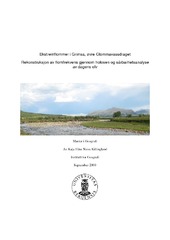Ekstremflommer i Grimsa, øvre Glommavassdraget. Rekonstruksjon av flomfrekvens gjennom holosen og sårbarhetsanalyse av dagens elv
Master thesis
Permanent lenke
https://hdl.handle.net/1956/3543Utgivelsesdato
2009-09-02Metadata
Vis full innførselSamlinger
- Department of Geography [634]
Sammendrag
Reconstruction of magnitude and frequency of former extreme floods can improve modelling and forecasting of future flood events. In order to expand the time series of large-scale floods in Eastern Norway, a paleoflood study of the river Grimsa, in the upper Glomma catchment, South-East Central Norway, has been conducted. A lacustrine sediment core is used for frequency estimation. As a result, 14 extreme floods are identified through Holocene, during the periods 290 - 790, 1.230 - 1.500, 1.960 - 3.390, 5.800 and 9.000 cal. yr BP. These have a recurrence interval of 650 yrs. The three largest floods identified have a frequency of 0.0003. Estimated magnitude of 100 and 1000-year floods in Grimsa is 300 and 580 m3/s, respectively. This study also examines, through fluvial geomorphology, the sensitivity of the river Grimsa for external disturbance. The river is seen as relative stable today, but the sediment budget can increase drastically with enhanced discharge. Finally, the paleoflood record is compared to flood records from Norway and Europe, and further, reconstructions of paleotemperature and precipitation from glaciers in southern Norway are compared. The impact of the North Atlantic Oscillation (NAO) on regional flood patterns is evaluated. 8 of the floods correlate with a positive NAO, but a more extensive study is needed to understand the dynamics of this fluctuation.
Utgiver
The University of BergenOpphavsrett
The authorCopyright the author. All rights reserved
